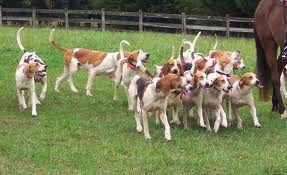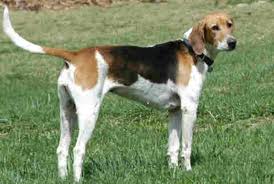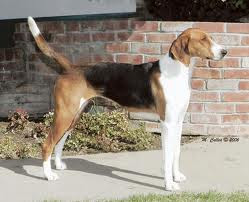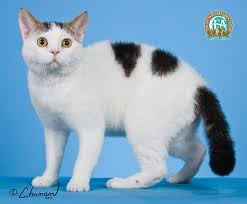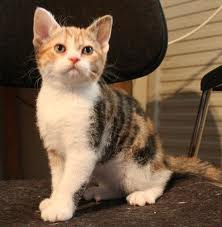Description
Illustration of German Longhaired Pointer
This breed was re-introduced to Great Britain in the 1990s and recognised by the Kennel Club in 1997. Previously, German Longhaired Pointers were present in Great Britain in the 1890s.
He is one of three German Pointers now recognised in the UK, the Shorthaired and Wirehaired having been here for much longer. They differ not only in their coats but also in their body proportions and size. He is the largest of the three.
He was first shown at a show in Frankfurt in 1878, where the first standard was produced. Interestingly, the Shorthaired standard was produced in Germany at the same time, while that for the Wirehaired was produced three years later.
Illustration of German Longhaired Pointer
This breed was re-introduced to Great Britain in the 1990s and recognised by the Kennel Club in 1997. Previously, German Longhaired Pointers were present in Great Britain in the 1890s.
He is one of three German Pointers now recognised in the UK, the Shorthaired and Wirehaired having been here for much longer. They differ not only in their coats but also in their body proportions and size. He is the largest of the three.
He was first shown at a show in Frankfurt in 1878, where the first standard was produced. Interestingly, the Shorthaired standard was produced in Germany at the same time, while that for the Wirehaired was produced three years later.
 |
| German Longhaired Pointer |
Like the other German Pointers, he works as a Hunt, Point and Retrieve Gundog. He has been enthusiastically worked in the UK, and has gained Field Trial awards. He has also been successfully shown, but he is very much a dog for the country.
The German longhaired pointer (GLP) is a breed of dog. It was developed in Germany, and is used as a gundog.It is closely related to its cousin, the German Shorthaired Pointer, or the GSP.
Appearance
The GLP should be muscular, elegant, and athletic. It should not be bulky or cumbersome, and it should be able to move with great speed and freedom. It has moderate bone, but has substance, and must never look frail or weak. Its appearance should reflect its excitable, crazy temperament. Like all German pointers, they have webbed feet. Watch out for aggression in puppy years.
The German longhaired pointer (GLP) is a breed of dog. It was developed in Germany, and is used as a gundog.It is closely related to its cousin, the German Shorthaired Pointer, or the GSP.
Appearance
The GLP should be muscular, elegant, and athletic. It should not be bulky or cumbersome, and it should be able to move with great speed and freedom. It has moderate bone, but has substance, and must never look frail or weak. Its appearance should reflect its excitable, crazy temperament. Like all German pointers, they have webbed feet. Watch out for aggression in puppy years.
 |
| German Longhaired Pointer |
Coat and color
The coat is medium length, about 3 to 5 cm (1.2 to 2.0 in) long on the body, with the feathering somewhat longer. The coat is slightly wavy, but must not be curly. It is not silky or soft, but rather firm and shiny. It always has a double coat, with the undercoat being quite dense, but not so profuse as to make the guard hairs stand out from the body. The color is solid liver with white permitted on the chest, paws, and down the top of the muzzle, or dark brown roan, with large patches of solid brown, especially on the head, ears, back, and base of the tail.
Size
The GLP is between 60–70 cm (24–28 in) at the withers for males, and 58–66 cm (23–26 in) for females. It weighs approximately 30 kilograms (66 lb).
Gait
The strides should be long and free, with strong drive from the hindquarters, and good reach from the front.
The coat is medium length, about 3 to 5 cm (1.2 to 2.0 in) long on the body, with the feathering somewhat longer. The coat is slightly wavy, but must not be curly. It is not silky or soft, but rather firm and shiny. It always has a double coat, with the undercoat being quite dense, but not so profuse as to make the guard hairs stand out from the body. The color is solid liver with white permitted on the chest, paws, and down the top of the muzzle, or dark brown roan, with large patches of solid brown, especially on the head, ears, back, and base of the tail.
Size
The GLP is between 60–70 cm (24–28 in) at the withers for males, and 58–66 cm (23–26 in) for females. It weighs approximately 30 kilograms (66 lb).
Gait
The strides should be long and free, with strong drive from the hindquarters, and good reach from the front.
Temperament
GLPs are a kind, gentle, friendly, and intelligent breed. They are very affectionate, and may experience separation anxiety. They only make good pets when properly exercised, as they need a "job" to do, and do not adapt well to a sedentary life. The GLP is an excellent family pet, as it enjoys playing with children. It is very sociable with dogs.
Care
The GLP is very trainable, and loves to work. Because of this, it needs large amounts of exercise daily, needing more than most pet owners can give. It is not well suited for urban life, as it thrives on having lots of room to run and swim. Its ideal setting would be in a rural area, with an active owner who hunts with the dog on a regular basis. GLPs need a moderate amount of grooming about once or twice a week. They are highly intelligent, very trainable, and athletic, traits which make them suitable for many dog sports, especially field trials, obedience, and agility.
Health
GLPs, because they are quite rare in most parts of the world, and thus are unprofitable to irresponsible breeders such as puppy mills and backyard breeders, do not have any genetic disorders that are prevalent in the breed. Their ears are mildly prone to infection, a problem which is easily avoided by cleaning the dog's ears on a regular basis, as well as after swimming.
HISTORY :
The GLP was developed in Germany for use as a pointer. It was originally a rather slow dog, and was crossed with setters and English Pointers in the 19th century to improve speed. It was very stubborn and temperamental, and has since been bred for a steady, friendly temperament. It was first shown in 1878 in Frankfurt, and at this time the first breed standard was written. Breeders then began to focus their efforts on producing dogs that performed equally well in the field and the show ring, an endeavour that is continued by breeders today. The Large Munsterlander was developed from the GLP after it was decided that GLPs must only be brown-and-white, the black-and-white strain became the ancestors of the Large Munsterlander.
GLPs are a kind, gentle, friendly, and intelligent breed. They are very affectionate, and may experience separation anxiety. They only make good pets when properly exercised, as they need a "job" to do, and do not adapt well to a sedentary life. The GLP is an excellent family pet, as it enjoys playing with children. It is very sociable with dogs.
Care
The GLP is very trainable, and loves to work. Because of this, it needs large amounts of exercise daily, needing more than most pet owners can give. It is not well suited for urban life, as it thrives on having lots of room to run and swim. Its ideal setting would be in a rural area, with an active owner who hunts with the dog on a regular basis. GLPs need a moderate amount of grooming about once or twice a week. They are highly intelligent, very trainable, and athletic, traits which make them suitable for many dog sports, especially field trials, obedience, and agility.
Health
GLPs, because they are quite rare in most parts of the world, and thus are unprofitable to irresponsible breeders such as puppy mills and backyard breeders, do not have any genetic disorders that are prevalent in the breed. Their ears are mildly prone to infection, a problem which is easily avoided by cleaning the dog's ears on a regular basis, as well as after swimming.
HISTORY :
The GLP was developed in Germany for use as a pointer. It was originally a rather slow dog, and was crossed with setters and English Pointers in the 19th century to improve speed. It was very stubborn and temperamental, and has since been bred for a steady, friendly temperament. It was first shown in 1878 in Frankfurt, and at this time the first breed standard was written. Breeders then began to focus their efforts on producing dogs that performed equally well in the field and the show ring, an endeavour that is continued by breeders today. The Large Munsterlander was developed from the GLP after it was decided that GLPs must only be brown-and-white, the black-and-white strain became the ancestors of the Large Munsterlander.



